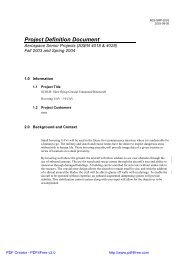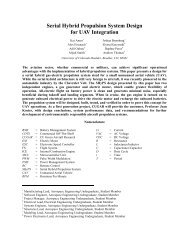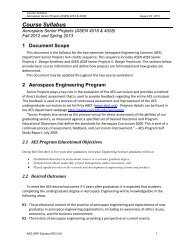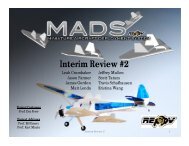PFR - Aerospace Engineering Sciences Senior Design Projects ...
PFR - Aerospace Engineering Sciences Senior Design Projects ...
PFR - Aerospace Engineering Sciences Senior Design Projects ...
You also want an ePaper? Increase the reach of your titles
YUMPU automatically turns print PDFs into web optimized ePapers that Google loves.
Project Final Report – CUDBF April 30 th , 2009<br />
ASEN 4028: <strong>Aerospace</strong> <strong>Senior</strong> <strong>Projects</strong><br />
Figure 128: Competition lap flown on flight test #7<br />
After the successful completion of flight test #7, without any pilot complaints, flight test #8 was<br />
conducted using the full four rocket payload (6.0 lbs of total payload). The goal of this flight was<br />
to collect data on takeoff speed, landing speed, and average current draw. Takeoff and landing<br />
speed were predicted using 1.3*Vstall. With the four rocket payload, takeoff and landing speed<br />
were predicted to be 35 mph. Takeoff speed was 35 mph, and landing speed occurred at 33 mph.<br />
Figure 129: Flight pictures from flight test #8<br />
The average current draw was 21.9 amps, slightly above the 20 amps predicted. A plot of the<br />
predicted versus actual current draw is shown in Figure 130. The blue line represents the<br />
predicted value, and the red line represents the actual value. The small discrepancy can be<br />
attributed to variations in pilot flying style. The average speed during the flight was 44.8 mph,<br />
very close to the 43 mph average speed during the empty flight. This data confirms that the pilot<br />
chose to fly at a constant airspeed, rather than a constant power setting. Ultimately, all these<br />
values proved to be close to the predicted values. Flight test #8 ended with a broken nose gear<br />
upon landing.<br />
144
















